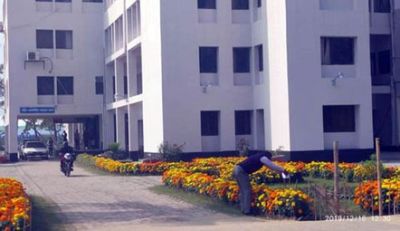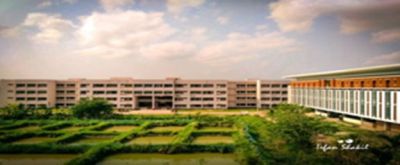Khulna University
University of Khulna the 9th public University of the country, is located on Khulna-Satkhira highway and by Mayur river, on 107.27 acres of land 4 km away from the heart of the city, under the Khulna University Act 1990 passed in Parliament. A strong public demand arose for setting up a university in Khulna long ago. In 1974 the importance of establishing a university in Khulna Division was first mentioned in the report of Kudrat-e-Khuda Commission. In November 1979, the Cabinet took the decision for establishing a Technical University, but the local people demanded a general university. In 1985 the government formed two committees: (i) 'Zillur Rahman Siddiqui Committee' for preparing academic and administrative programmes and (ii) 'Mahbubuzzaman Committee' for the selection of site. On 4 January 1987, the government finalised the programme of establishing a university at Khulna on the basis of the reports of the above committees.

In August 1991, Prof Dr Golam Rahman was appointed the first Vice-chancellor. On August 31, 1991 the university started its academic programmes at Bachelor level with four disciplines viz, Computer Science and Engineering, Architecture, Urban and Rural Planning under Science, Engineering and Technology (SET) School and Management (at present Business Administration) under Management and Business Administration (MBA) School with a total of 80 students, 20 students in each discipline, in a two storied building.
Under Life Science School the University housed the Disciplines of Forestry and Wood Technology, Marine Biology (As present Fisheries and Marine Resource Technology) in 1992, Biotechnology and Genetic Engineering and Agrotechnology in 1995; Environmental Science in 1996; Pharmacy and Soil Science (At present Soil, Water and Environment Discipline) in 1998.
Under SET School the University opened Electronics and Communication Engineering in 1997; Mathematics in 1998 and Physics and Chemistry in 2009 and Statistics Discipline in 2011. Under Arts and Humanities School, the University opened English Discipline in 1998 and Bangla in 2010, and History and Civilization Discipline in 2016. Under Social Science School Economics Discipline in 1999 and Sociology Discipline in 2003, Development Studies in 2011 and Mass Communication and Journalism Discipline in 2015 are active. Under Management and Business Administration School, the University opened Human Resource Management Discipline in 2016. Under the School of Law, Law Discipline started in 2017. The School of Education began its journey from the academic year 2017–2018, with one discipline: Institute of Education and Research. The University launched Center of Excellence in Teaching and Learning in 2015. However, the Schools, Disciplines, Center and Institute are now offering both undergraduate and post graduate degrees including PhDs, Postgraduate Diplomas, and Certificate Courses.

Khulna has a century old art educational institution called Khulna Art College in the southern part of Bangladesh. Khulna University absorbed Khulna Art College into its own administrative authority and the said college was converted into Institute of Fine Arts in 2009. Later on The Institute was again converted into Fine Arts School in 2014. Fine Arts School launched three disciplines: Drawing and Painting, Print Making and Sculpture Discipline. Thus, at present there are eight schools and one Institute in Khulna University, which have 29 disciplines. Modern Language Center (MLC) and Center for Integrated Studies on the Sundarbans (CISS) started in 2001. Khulna City Corporation Women's College is affiliated to this University. The first, second, third, fourth, fifth and sixth convocations were held in 1997, 2001, 2005, 2010, 2015 and 2019 respectively. The first and second senate meetings were held in 2003 and 2007 respectively.
Aims and Objectives of this University are to impart technology based and need-oriented higher education befitting the age; to generate skilled manpower in order to exploit, utilise and conserve available resources for sustainable development of the country; to maintain the highest academic standard in line with the international standard of education; to undertake fundamental and applied research and to produce capable manpower to fulfilling the global demands. English, Computer, Bangla and History of Emergence of Bangladesh courses are compulsory for all the Disciplines.

There are 30 modern laboratories, Computer Laboratories, Building Science, Acoustic and Lighting laboratories for modern architectural design, Biotechnology laboratories, Tissues Culture Laboratory, Centre for Geographic Information System (CGIS), Photogrammetry and Remote Sensing Laboratory for using Landsat imageries and inventory purpose. There are farms and nurseries. The University has also set up Field and Laboratories, Seismograph Machine and Coastal Fisheries Research Station.
The University has an excellent and peaceful academic environment, free from session delay and student politics. An academic calendar is prepared every year and approved by the Academic Council Classes 13 weeks; preparatory leave 2 weeks; conduct of examinations 3 weeks and results preparation 3 weeks. The University of Khulna has now (2020) 6980 students including 19 foreign students, 487 teachers, 298 officers and 349 supporting staffs.
On the campus there are two administrative buildings, two four-storied and one two-storied academic buildings, an Open Stage, two Mosques, a Cafeteria, Agrani Bank, University Rest House, Post Office with e-mail and Internet facilities, Vice-chancellor's Bungalow, some resident quarters for the Professors, Associate Professors, Assistant Professors/Lecturers, officers and employees. There are five student halls of residence, three for male students and two for female students, accommodated a good number of students. Besides, on the campus there are a central Shahid Minar, Sculpture of Liberation War Memorial, Katka Tragedy Memorial, in memory of eleven students, drowned in Katka beach when on a study tour and Kaljayee Mujib Mural signifying Mujib Year 2020-2021.
There is Kazi Nazrul Islam Central Library established in 1991 and also a library called Shirley Islam Library (Shirley Islam is the deceased wife of Professor Mozaharul Islam who, living in England, made a fat donation for the establishment of this library). The libraries have about 45,500 books and 5000 journals and under computer network. The library has a computer network for communication with national and international universities and institutions through the Internet. The library is linked with the Automation and Networking of Science Technology Libraries in Bangladesh (BANSLINK) a pilot project of the Ministry of Science and Technology, government of Bangladesh and Bangladesh National Scientific and Technical Documentation Center (BANSDOC) is the executing agency of the Project. Khulna University also linked with Bangladesh Education and Research Network. (BERNET) Project organized by University Grants Commission (UGC), Bangladesh.
The University provides an ample scope for teachers for research activities and conducting projects. The Research Cell set up in 2000 also established the Internet backbone. The research journal of the University titled ‘Khulna University Studies’ is being published regularly. Besides, some Disciplines publish their own research journals. Khulna University ‘Barta’ containing current activities is published quarterly. The University medical centre has seven full time physicians, an emergency ward and two ambulances, X-ray machine and Dental Unit. Pathological test facilities are also available here.
The University has facilities for both indoor and outdoor games like football, cricket, volleyball, badminton, basketball and tennis. The students participate in national and international debate competitions. The halls hold their annual cultural functions. Also, a number of students' cultural groups hold programmes.
The University has established academic associations with different universities and organizations at home and abroad. The University always takes initiatives and drives to utilize various possibilities and resources available to create global standard manpower in the country. [Gazi Abdulla-hel Baqui]
References Md. Nazrul Islam and Gazi Abdulla-hel Baqui (ed), Khulna Bishabiddalayer Itihash, 2012; Annual Report 2017-2018 Khulna University, 24 November 2020.
